Phoenix dactylifera (Ajwa Dates) Alleviate LPS-Induced Sickness Behaviour in Rats by Attenuating Proinflammatory Cytokines and Oxidative Stress in the Brain
Abstract
1. Introduction
2. Results
2.1. Standardisation of PDF
2.2. Effect of PDF on Water and Food Intake in LPS-Treated Rats
2.3. Effect of PDF on Behavioural Outcomes
2.3.1. Locomotor Activity Scores
2.3.2. Tail Suspension Test
2.3.3. Despair Behaviour Test
2.4. Effect of PDF on ALT and AST Levels in Serum
2.5. Tissue Biochemical Parameters
2.5.1. Effect of PDF on Oxidative and Nitrative Stress
2.5.2. Effect of PDF on TNF-α and IL-6 Levels
3. Discussion
4. Material and Methods
4.1. Drug and Chemicals
4.2. Animals
4.3. Extract Preparation
4.4. Standardisation of PDF
4.4.1. Total Phenolic Content and Flavonoid Content Determination
4.4.2. Estimation of Quercetin Using HPLC
4.5. Experimental Grouping and Treatment
4.6. Behavioural Parameters
4.6.1. Locomotor Activity Scores
4.6.2. Tail Suspension Test
4.6.3. Despair Behaviour Test
4.7. Estimation of ALT and AST Levels in Serum
4.8. Biochemical Estimations in Brain Tissue
4.8.1. Tissue Preparation
4.8.2. Oxidative and Nitrative Stress Parameters
4.8.3. Estimation of IL-6 and TNF-α Levels
4.9. Statistical Analyses
5. Conclusions
Author Contributions
Funding
Institutional Review Board Statement
Informed Consent Statement
Data Availability Statement
Acknowledgments
Conflicts of Interest
References
- Khan, F.; Khan, T.J.; Kalamegam, G.; Pushparaj, P.N.; Chaudhary, A.; Abuzenadah, A.; Kumosani, T.; Barbour, E.; Al-Qahtani, M. Anti-cancer effects of Ajwa dates (Phoenix dactylifera L.) in diethylnitrosamine induced hepatocellular carcinoma in Wistar rats. BMC Complement. Altern. Med. 2017, 17, 418. [Google Scholar] [CrossRef]
- Alshwyeh, H.A. Phenolic profiling and antibacterial potential of Saudi Arabian native date palm (Phoenix dactylifera) cultivars. Int. J. Food Prop. 2020, 23, 627–638. [Google Scholar] [CrossRef]
- Aljuhani, N.; Elkablawy, M.A.; Elbadawy, H.M.; Alahmadi, A.M.; Aloufi, A.M.; Farsi, S.H.; Alhubayshi, B.S.; Alhejaili, S.S.; Alhejaili, J.M.; Abdel-Halim, O.B. Protective effects of Ajwa date extract against tissue damage induced by acute diclofenac toxicity. J. Taibah Univ. Med. Sci. 2019, 14, 553–559. [Google Scholar] [CrossRef] [PubMed]
- Bassem, Y.S.; Wael, M.E.; Abdulrahman, H.S.; Bassem Yousef, S.; Al-Moalim, M.A.B.L. Ajwa dates as a protective agent against liver toxicity in rat. Eur. Sci. J. ESJ 2014, 10, 358–368. [Google Scholar] [CrossRef]
- Sabbah, M.; Alshubali, F.; Baothman, O.A.S.; Zamzami, M.A.; Shash, L.S.; Hassan, I.A. Cardioprotective Effect of Ajwa Date Aqueous Extract on Doxorubicin-Induced Toxicity in Rats. Biomed. Pharmacol. J. 2018, 11, 1521–1536. [Google Scholar] [CrossRef]
- Pujari, R.R.; Vyawahare, N.S.; Kagathara, V.G. Evaluation of antioxidant and neuroprotective effect of date palm (Phoenix dactylifera L.) against bilateral common carotid artery occlusion in rats. Indian J. Exp. Biol. 2011, 49, 627–633. [Google Scholar]
- Alqarni, M.M.M.; Osman, M.A.; Al-Tamimi, D.S.; Gassem, M.A.; Al-Khalifa, A.S.; Al-Juhaimi, F.; Mohamed Ahmed, I.A. Antioxidant and antihyperlipidemic effects of Ajwa date (Phoenix dactylifera L.) extracts in rats fed a cholesterol-rich diet. J. Food Biochem. 2019, 43, e12933. [Google Scholar] [CrossRef]
- Zhang, C.-R.; Aldosari, S.A.; Vidyasagar, P.S.P.V.; Nair, K.M.; Nair, M.G. Antioxidant and Anti-inflammatory Assays Confirm Bioactive Compounds in Ajwa Date Fruit. J. Agric. Food Chem. 2013, 61, 5834–5840. [Google Scholar] [CrossRef]
- Turner, M.D.; Nedjai, B.; Hurst, T.; Pennington, D.J. Cytokines and chemokines: At the crossroads of cell signalling and inflammatory disease. Biochim. Biophys. Acta BBA Mol. Cell Res. 2014, 1843, 2563–2582. [Google Scholar] [CrossRef]
- Siddiqui, S.; Ahmad, R.; Khan, M.A.; Upadhyay, S.; Husain, I.; Srivastava, A.N. Cytostatic and Anti-tumor Potential of Ajwa Date Pulp against Human Hepatocellular Carcinoma HepG2 Cells. Sci. Rep. 2019, 9, 245. [Google Scholar] [CrossRef]
- Al-Shahib, W.; Marshall, R.J. The fruit of the date palm: Its possible use as the best food for the future? Int. J. Food Sci. Nutr. 2003, 54, 247–259. [Google Scholar] [CrossRef] [PubMed]
- Rahmani, A.H.; Aly, S.M.; Ali, H.; Babiker, A.Y.; Srikar, S.; Khan, A.A. Therapeutic effects of date fruits (Phoenix dactylifera) in the prevention of diseases via modulation of anti-inflammatory, anti-oxidant and anti-tumour activity. Int. J. Clin. Exp. Med. 2014, 7, 483–491. [Google Scholar]
- Alotaibi, G.H.; Shivanandappa, T.B.; Chinnadhurai, M.; Reddy Dachani, S.; Dabeer Ahmad, M.; Abdullah Aldaajanii, K. Phytochemistry, Pharmacology and Molecular Mechanisms of Herbal Bioactive Compounds for Sickness Behaviour. Metabolites 2022, 12, 1215. [Google Scholar] [CrossRef] [PubMed]
- Wilsterman, K.; Alonge, M.M.; Ernst, D.K.; Limber, C.; Treidel, L.A.; Bentley, G.E. Flexibility in an emergency life-history stage: Acute food deprivation prevents sickness behaviour but not the immune response. Proc. R. Soc. B Biol. Sci. 2020, 287, 20200842. [Google Scholar] [CrossRef] [PubMed]
- Maes, M.; Berk, M.; Goehler, L.; Song, C.; Anderson, G.; Gałecki, P.; Leonard, B. Depression and sickness behavior are Janus-faced responses to shared inflammatory pathways. BMC Med. 2012, 10, 66. [Google Scholar] [CrossRef] [PubMed]
- Cunningham, C.; Maclullich, A.M. At the extreme end of the psychoneuroimmunological spectrum: Delirium as a maladaptive sickness behaviour response. Brain Behav. Immun. 2013, 28, 1–13. [Google Scholar] [CrossRef]
- Prather, A.A. Sickness Behavior. In Encyclopedia of Behavioral Medicine; Gellman, M.D., Turner, J.R., Eds.; Springer New York: New York, NY, USA, 2013; pp. 1786–1788. [Google Scholar]
- Eisenberger, N.I.; Moieni, M.; Inagaki, T.K.; Muscatell, K.A.; Irwin, M.R. In Sickness and in Health: The Co-Regulation of Inflammation and Social Behavior. Neuropsychopharmacology 2017, 42, 242–253. [Google Scholar] [CrossRef]
- McCusker, R.H.; Kelley, K.W. Immune-neural connections: How the immune system’s response to infectious agents influences behavior. J. Exp. Biol. 2013, 216, 84–98. [Google Scholar] [CrossRef]
- Dantzer, R.; BluthÉ, R.-M.; Castanon, N.; Kelley, K.W.; Konsman, J.-P.; Laye, S.; Lestage, J.; Parnet, P. Chapter 14—Cytokines, Sickness Behavior, and Depression. In Psychoneuroimmunology, 4th ed.; Ader, R., Ed.; Academic Press: Burlington, MA, USA, 2007; pp. 281–318. [Google Scholar]
- Shattuck, E.C.; Muehlenbein, M.P. Human sickness behavior: Ultimate and proximate explanations. Am. J. Phys. Anthropol. 2015, 157, 1–18. [Google Scholar] [CrossRef] [PubMed]
- Tastan, B.; Arioz, B.I.; Tufekci, K.U.; Tarakcioglu, E.; Gonul, C.P.; Genc, K.; Genc, S. Dimethyl Fumarate Alleviates NLRP3 Inflammasome Activation in Microglia and Sickness Behavior in LPS-Challenged Mice. Front. Immunol. 2021, 12, 737065. [Google Scholar] [CrossRef]
- Shaikh, A.; Dhadde, S.B.; Durg, S.; Veerapur, V.P.; Badami, S.; Thippeswamy, B.S.; Patil, J.S. Effect of Embelin Against Lipopolysaccharide-induced Sickness Behaviour in Mice. Phytother. Res. PTR 2016, 30, 815–822. [Google Scholar] [CrossRef] [PubMed]
- Kinra, M.; Ranadive, N.; Mudgal, J.; Zhang, Y.; Govindula, A.; Anoopkumar-Dukie, S.; Davey, A.K.; Grant, G.D.; Nampoothiri, M.; Arora, D. Putative involvement of sirtuin modulators in LPS-induced sickness behaviour in mice. Metab. Brain Dis. 2022, 37, 1969–1976. [Google Scholar] [CrossRef] [PubMed]
- Sadraie, S.; Kiasalari, Z.; Razavian, M.; Azimi, S.; Sedighnejad, L.; Afshin-Majd, S.; Baluchnejadmojarad, T.; Roghani, M. Berberine ameliorates lipopolysaccharide-induced learning and memory deficit in the rat: Insights into underlying molecular mechanisms. Metab. Brain Dis. 2019, 34, 245–255. [Google Scholar] [CrossRef] [PubMed]
- Wang, H.; Meng, G.L.; Zhang, C.T.; Wang, H.; Hu, M.; Long, Y.; Hong, H.; Tang, S.S. Mogrol attenuates lipopolysaccharide (LPS)-induced memory impairment and neuroinflammatory responses in mice. J. Asian Nat. Prod. Res. 2020, 22, 864–878. [Google Scholar] [CrossRef]
- Mani, V.; Arfeen, M.; Dhaked, D.K.; Mohammed, H.A.; Amirthalingam, P.; Elsisi, H.A. Neuroprotective Effect of Methanolic Ajwa Seed Extract on Lipopolysaccharide-Induced Memory Dysfunction and Neuroinflammation: In Vivo, Molecular Docking and Dynamics Studies. Plants 2023, 12, 934. [Google Scholar] [CrossRef]
- Dasgupta, A. Chapter 5–Liver Enzymes as Alcohol Biomarkers. In Alcohol and Its Biomarkers; Dasgupta, A., Ed.; Elsevier: San Diego, CA, USA, 2015; pp. 121–137. [Google Scholar]
- D’Mello, C.; Le, T.; Swain, M.G. Cerebral microglia recruit monocytes into the brain in response to tumor necrosis factoralpha signaling during peripheral organ inflammation. J. Neurosci. Off. J. Soc. Neurosci. 2009, 29, 2089–2102. [Google Scholar] [CrossRef]
- Chen, J.; Liu, S.; Wang, C.; Zhang, C.; Cai, H.; Zhang, M.; Si, L.; Zhang, S.; Xu, Y.; Zhu, J.; et al. Associations of Serum Liver Function Markers with Brain Structure, Function, and Perfusion in Healthy Young Adults. Front. Neurol. 2021, 12, 606094. [Google Scholar] [CrossRef]
- Mani, V.; Arfeen, M.; Sajid, S.; Almogbel, Y. Aqueous Ajwa dates seeds extract improves memory impairment in type-2 diabetes mellitus rats by reducing blood glucose levels and enhancing brain cholinergic transmission. Saudi J. Biol. Sci. 2022, 29, 2738–2748. [Google Scholar] [CrossRef]
- McDonald, S.; Prenzler, P.D.; Antolovich, M.; Robards, K. Phenolic content and antioxidant activity of olive extracts. Food Chem. 2001, 73, 73–84. [Google Scholar] [CrossRef]
- Olajirea, A.A.; Azeez, L.A. Total antioxidant activity, phenolic, flavonoid and ascorbic acid contents of Nigerian vegetables. Afr. J. Food Sci. 2011, 2, 22–29. [Google Scholar]
- Steru, L.; Chermat, R.; Thierry, B.; Simon, P. The tail suspension test: A new method for screening antidepressants in mice. Psychopharmacology 1985, 85, 367–370. [Google Scholar] [CrossRef]
- Porsolt, R.D.; Bertin, A.; Jalfre, M. Behavioral despair in mice: A primary screening test for antidepressants. Arch. Int. Pharmacodyn. Ther. 1977, 229, 327–336. [Google Scholar]
- Nagakannan, P.; Shivasharan, B.D.; Thippeswamy, B.S.; Veerapur, V.P. Restoration of brain antioxidant status by hydroalcoholic extract of Mimusops elengi flowers in rats treated with monosodium glutamate. J. Environ. Pathol. Toxicol. Oncol. Off. Organ Int. Soc. Environ. Toxicol. Cancer 2012, 31, 213–221. [Google Scholar] [CrossRef]
- Shivasharan, B.D.; Nagakannan, P.; Thippeswamy, B.S.; Veerapur, V.P. Protective Effect of Calendula officinalis L. Flowers Against Monosodium Glutamate Induced Oxidative Stress and Excitotoxic Brain Damage in Rats. Indian J. Clin. Biochem. IJCB 2013, 28, 292–298. [Google Scholar] [CrossRef]
- Ohkawa, H.; Ohishi, N.; Yagi, K. Assay for lipid peroxides in animal tissues by thiobarbituric acid reaction. Anal. Biochem. 1979, 95, 351–358. [Google Scholar] [CrossRef]
- Ellman, G.L. Tissue sulfhydryl groups. Arch. Biochem. Biophys. 1959, 82, 70–77. [Google Scholar] [CrossRef]
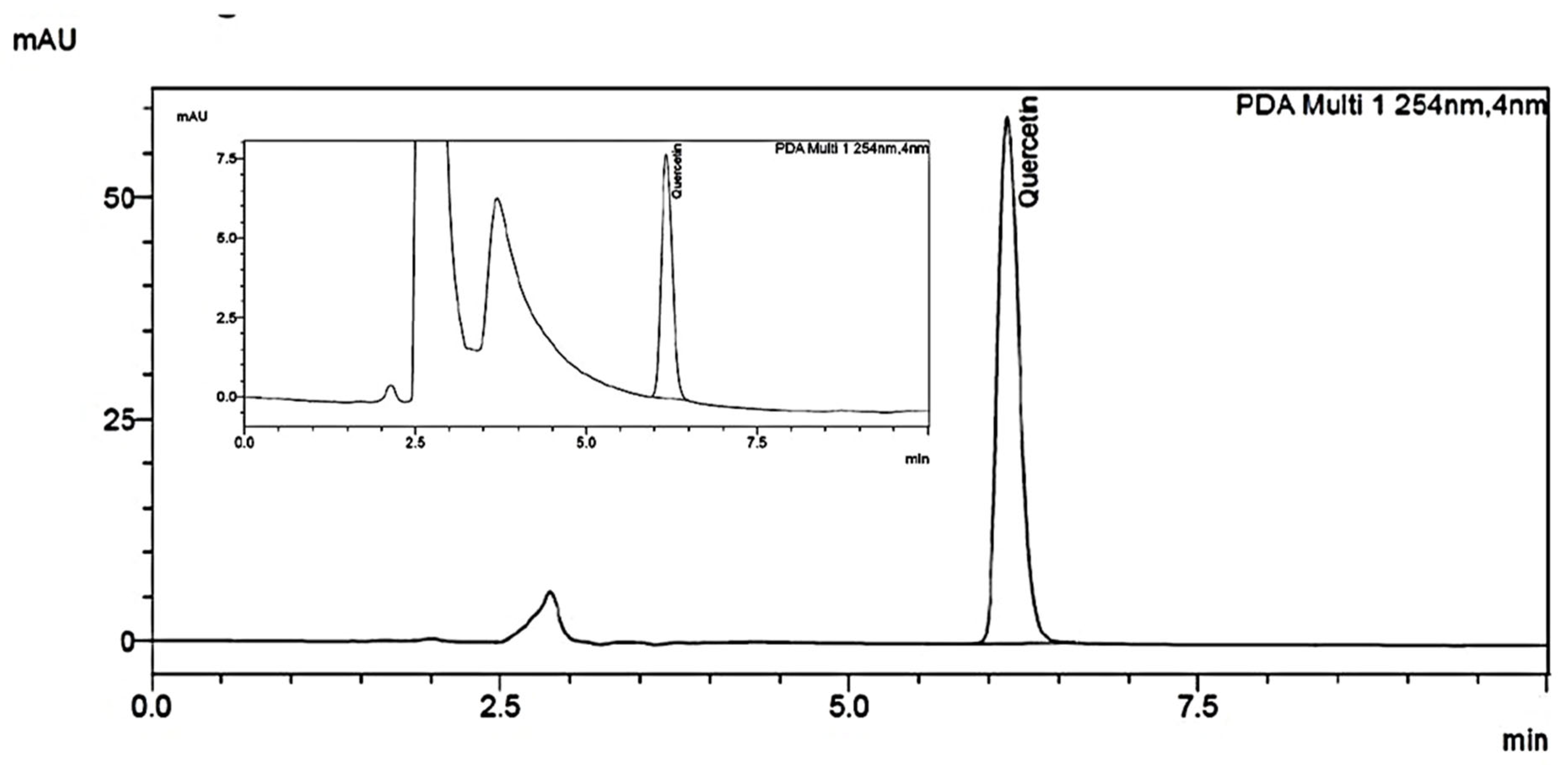
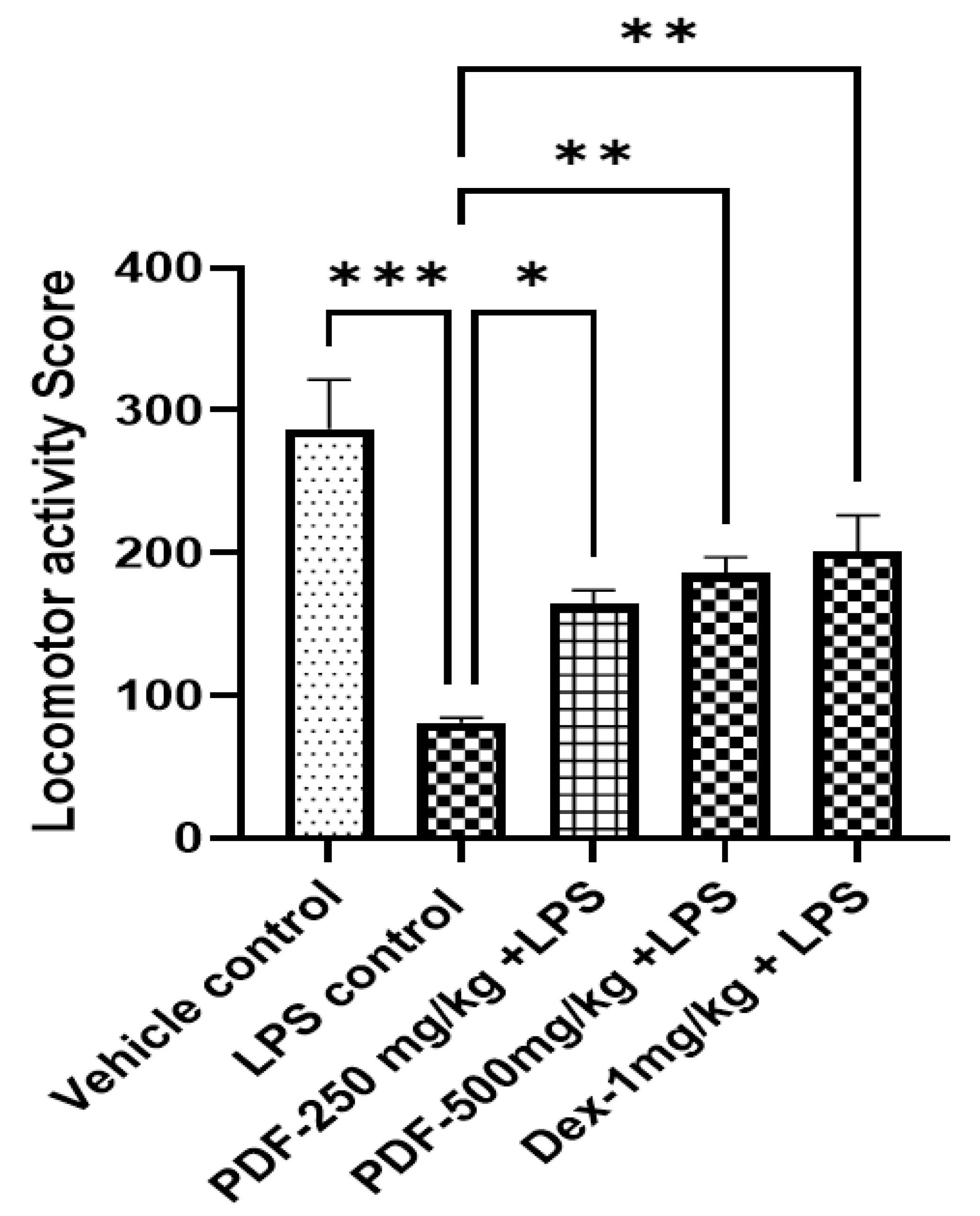
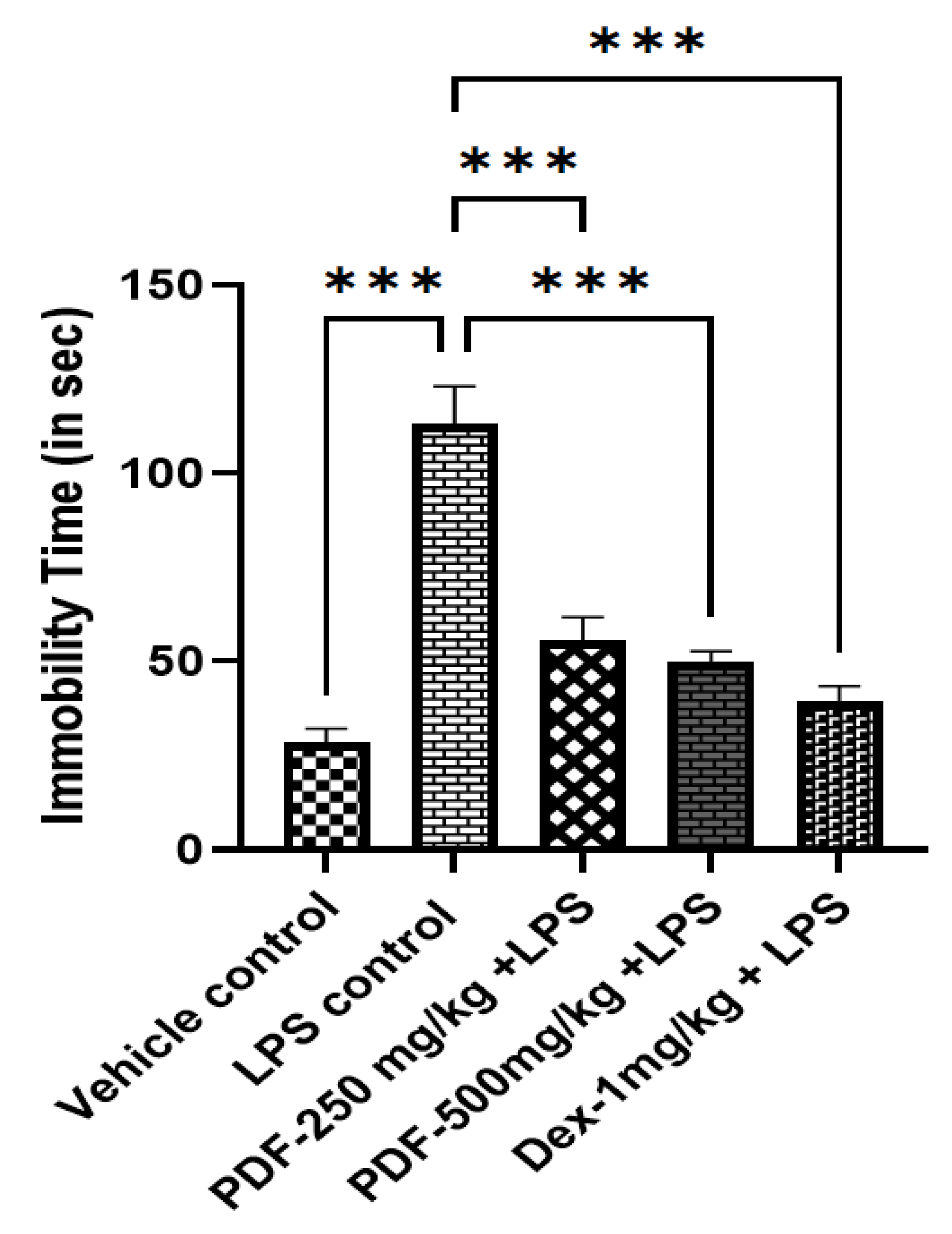
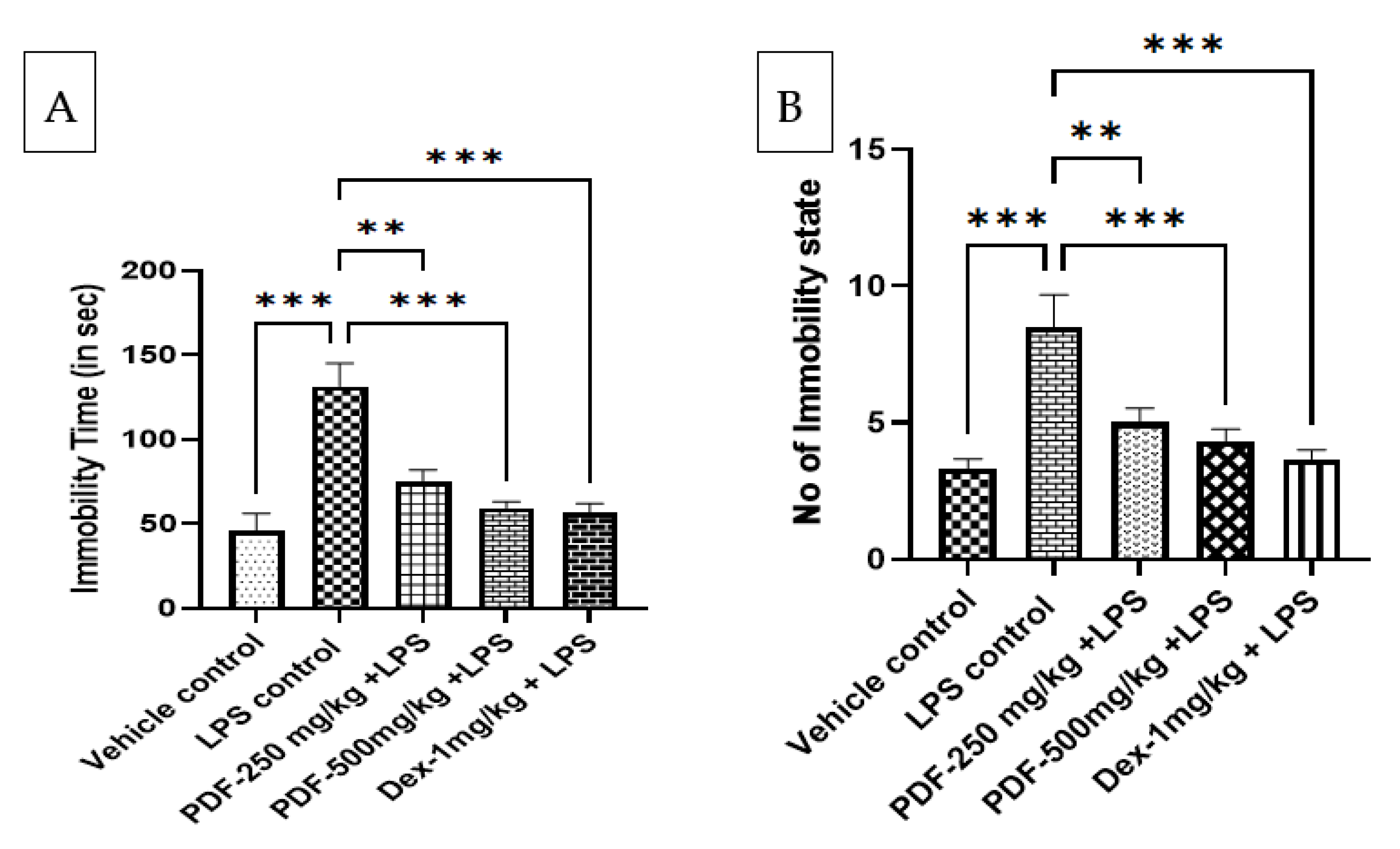
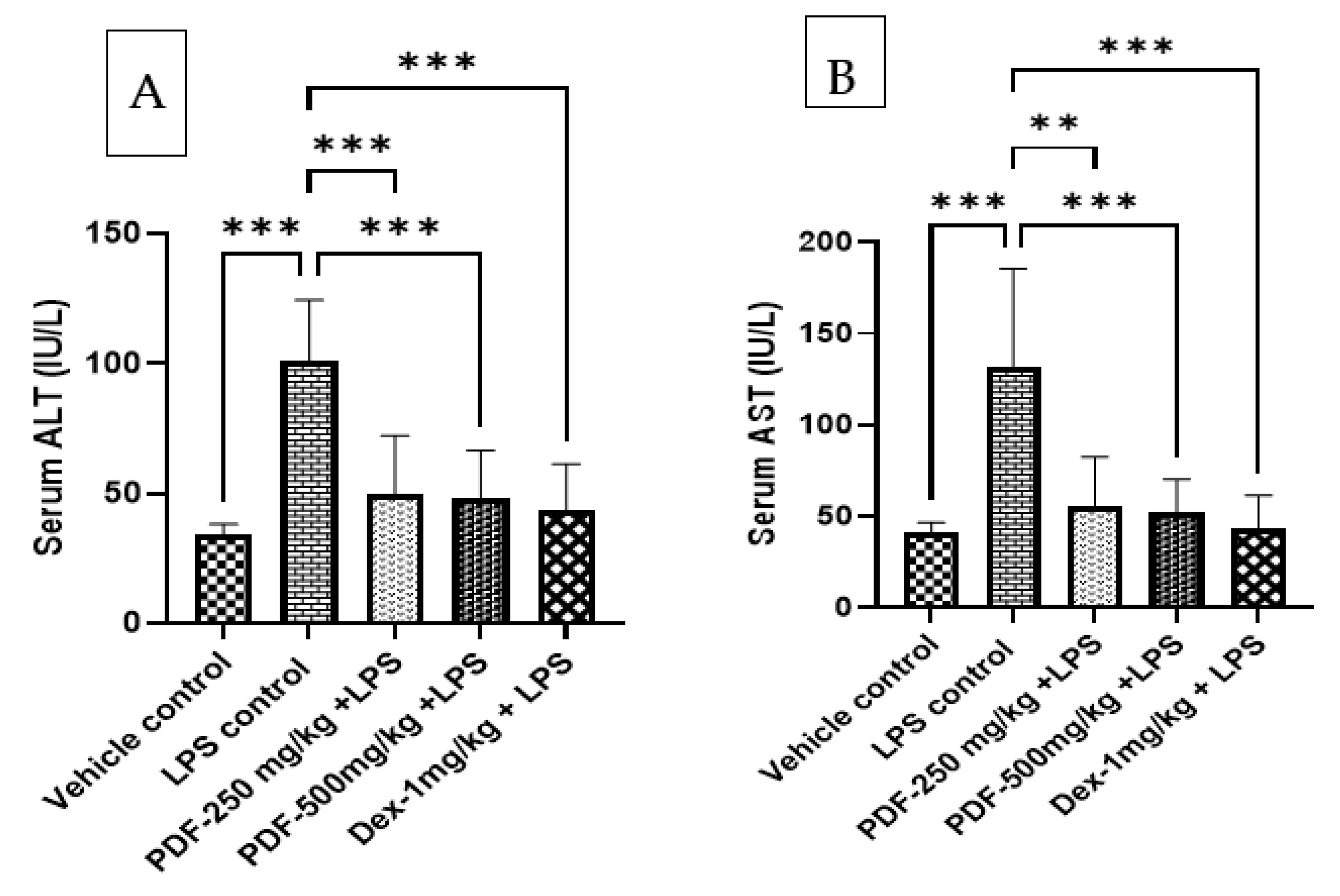
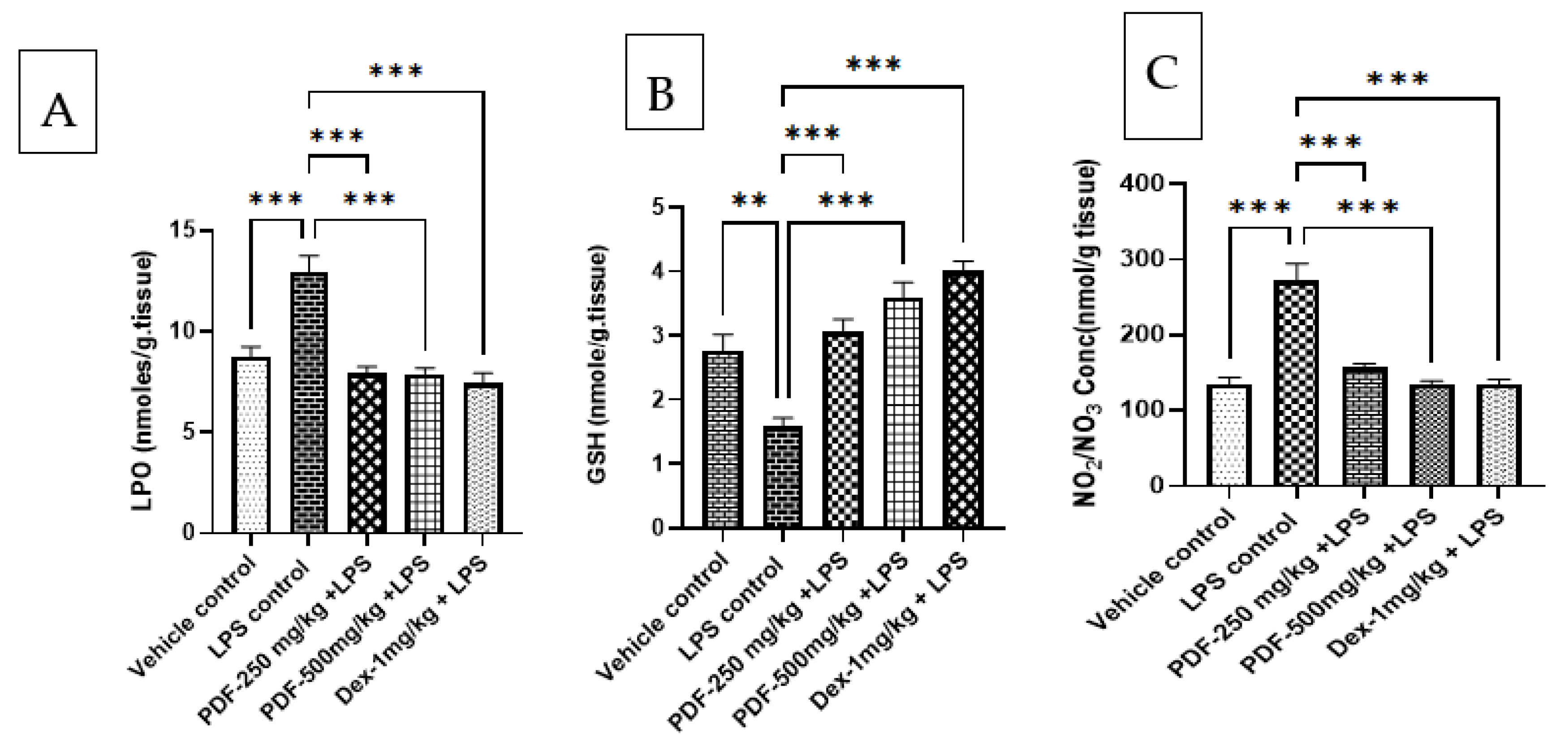
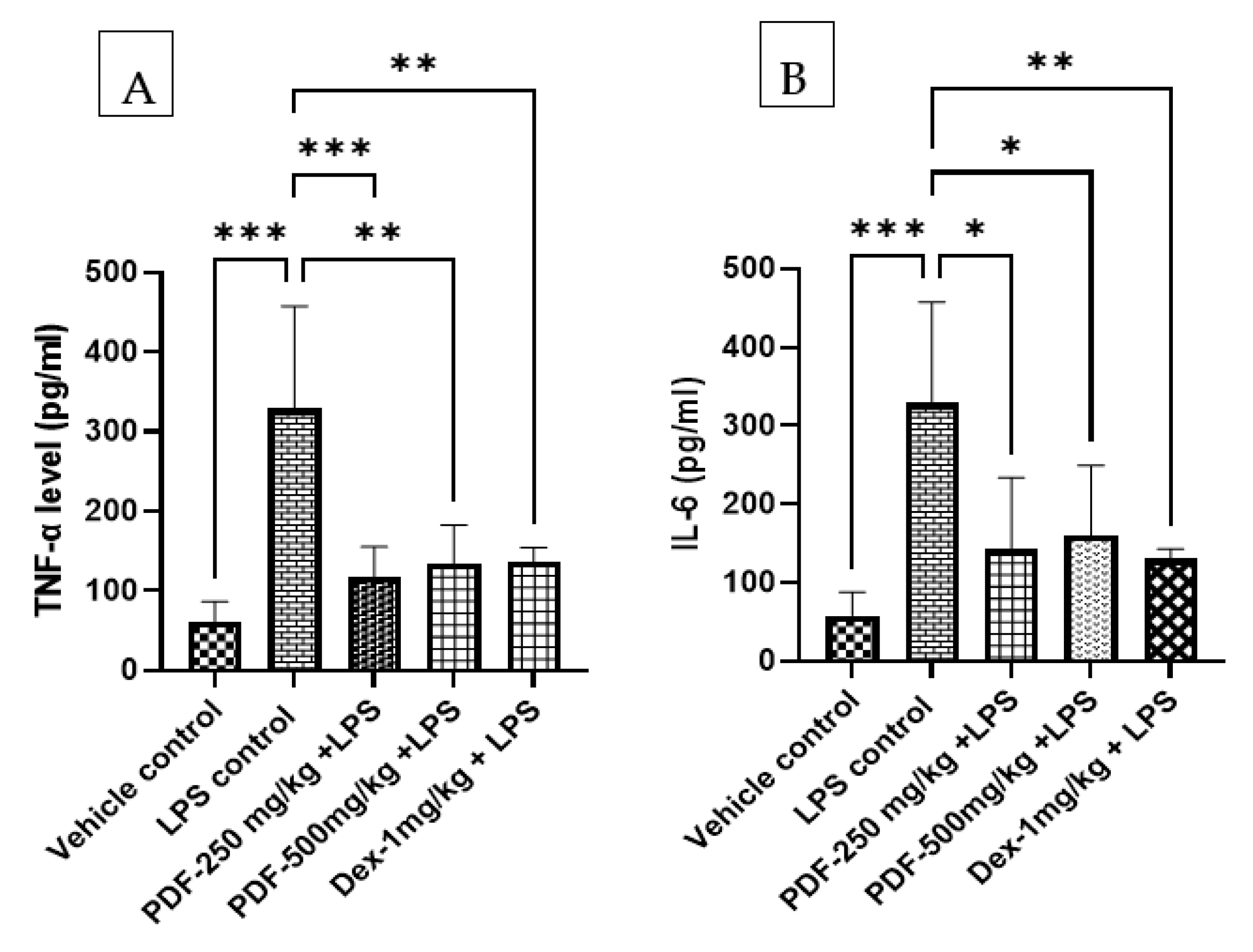
| Parameters | Vehicle Control | LPS Control | PDF-250 mg/kg + LPS | PDF-500 mg/kg + LPS | Dex-1 mg/kg + LPS |
|---|---|---|---|---|---|
| Water intake (mL/6 h) | 18.0 ± 0.60 | 6.52 ± 0.57 | 12.0 ± 0.46 | 15.3 ± 0.56 | 15.6 ± 0.59 |
| Food intake (g/6 h) | 6.00 ± 0.57 | 2.66 ± 0.16 | 4.50 ± 0.34 | 4.66 ± 0.33 | 4.83 ± 0.40 |
Disclaimer/Publisher’s Note: The statements, opinions and data contained in all publications are solely those of the individual author(s) and contributor(s) and not of MDPI and/or the editor(s). MDPI and/or the editor(s) disclaim responsibility for any injury to people or property resulting from any ideas, methods, instructions or products referred to in the content. |
© 2023 by the authors. Licensee MDPI, Basel, Switzerland. This article is an open access article distributed under the terms and conditions of the Creative Commons Attribution (CC BY) license (https://creativecommons.org/licenses/by/4.0/).
Share and Cite
Shivanandappa, T.B.; Alotaibi, G.; Chinnadhurai, M.; Dachani, S.R.; Ahmad, M.D.; Aldaajanii, K.A. Phoenix dactylifera (Ajwa Dates) Alleviate LPS-Induced Sickness Behaviour in Rats by Attenuating Proinflammatory Cytokines and Oxidative Stress in the Brain. Int. J. Mol. Sci. 2023, 24, 10413. https://doi.org/10.3390/ijms241310413
Shivanandappa TB, Alotaibi G, Chinnadhurai M, Dachani SR, Ahmad MD, Aldaajanii KA. Phoenix dactylifera (Ajwa Dates) Alleviate LPS-Induced Sickness Behaviour in Rats by Attenuating Proinflammatory Cytokines and Oxidative Stress in the Brain. International Journal of Molecular Sciences. 2023; 24(13):10413. https://doi.org/10.3390/ijms241310413
Chicago/Turabian StyleShivanandappa, Thippeswamy Boreddy, Ghallab Alotaibi, Maheswari Chinnadhurai, Sudharshan Reddy Dachani, Mahmad Dabeer Ahmad, and Khalid Abdullah Aldaajanii. 2023. "Phoenix dactylifera (Ajwa Dates) Alleviate LPS-Induced Sickness Behaviour in Rats by Attenuating Proinflammatory Cytokines and Oxidative Stress in the Brain" International Journal of Molecular Sciences 24, no. 13: 10413. https://doi.org/10.3390/ijms241310413
APA StyleShivanandappa, T. B., Alotaibi, G., Chinnadhurai, M., Dachani, S. R., Ahmad, M. D., & Aldaajanii, K. A. (2023). Phoenix dactylifera (Ajwa Dates) Alleviate LPS-Induced Sickness Behaviour in Rats by Attenuating Proinflammatory Cytokines and Oxidative Stress in the Brain. International Journal of Molecular Sciences, 24(13), 10413. https://doi.org/10.3390/ijms241310413







